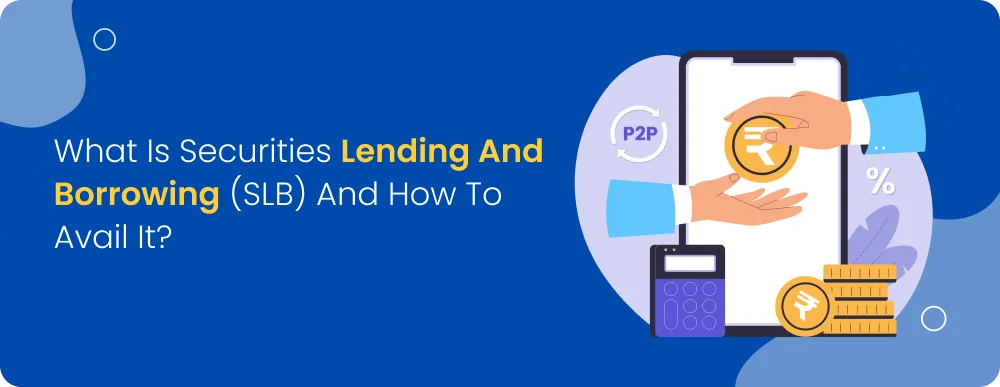What Is Securities Lending And Borrowing (SLB) And How To Avail It?
Noor Kaur
4 Nov 2025Tags:
Investing
key Takeaways
SLB lets investors lend idle shares for a fee and traders borrow stocks for short selling or delivery needs.
It’s a regulated, exchange-backed system ensuring transparency, full collateral, and guaranteed settlement.
Lenders earn passive income while keeping ownership benefits like dividends and bonuses.
Borrowers gain flexibility for arbitrage, hedging, or fulfilling F&O obligations.
Though low-risk, market, counterparty, and liquidity risks still exist, making due diligence and broker selection critical.
In simple terms, Securities Lending and Borrowing (SLB) allows investors to lend their idle stocks and earn additional income, while traders or institutions can borrow stocks to meet short-term trading or delivery needs.
This blog breaks down how the SLB mechanism works, who can participate, and how you can start lending or borrowing securities through your broker safely and efficiently.
What Is Securities Lending And Borrowing (SLB)?
Securities Lending and Borrowing (SLB) is a regulated mechanism that allows investors to lend their stocks or other securities to borrowers for a fixed period in exchange for a lending fee.
The system is managed by exchanges such as the NSE Lending and Borrowing platform, ensuring transparency, guaranteed settlement, and safety for both parties. Through SLB, investors can earn passive income from their idle portfolio holdings, while traders can borrow stocks for short selling, arbitrage, or fulfilling F&O delivery obligations.
How Does Securities Lending And Borrowing (SLB) Work?
In an SLB transaction, there are two key participants: the lender (investor) and the borrower (trader or institution).
Here’s how the process typically works:
Agreement Setup: Both parties enter into a Securities Lending Agreement, which specifies tenure, fees, and collateral.
Collateral Requirement: Borrowers must provide 100% collateral of the security’s value to ensure safety.
Execution: The transaction takes place on the exchange platform (NSE or BSE), where lending and borrowing quotes are matched.
Duration: Borrowing is done for a fixed period, usually up to 12 months.
Return of Securities: The borrower must return the exact securities to the lender before or on the expiry date.
Who Can Participate In Securities Lending And Borrowing (SLB)?
The Securities Lending and Borrowing framework is open to a range of market participants, including:
Retail investors looking to earn passive income from their long-term holdings.
Institutional investors such as mutual funds, insurance companies, and banks seeking to optimise returns on their portfolio.
Traders and brokers who need temporary access to stocks for short selling, arbitrage, or fulfilling derivative contract obligations.
Types Of Securities Covered In Securities Lending And Borrowing (SLB)
Not all financial instruments qualify as SLB; only those approved by SEBI and listed by the NSE or BSE are eligible.
Here’s what typically falls under SLB:
Equity Shares: Most large-cap and actively traded mid-cap stocks listed on the NSE/BSE.
Exchange-Traded Funds (ETFs): Select ETFs with sufficient liquidity may be allowed for lending and borrowing.
Government Securities and Bonds: In some cases, debt instruments with high credit ratings may be eligible.
Benefits Of Securities Lending And Borrowing (SLB)
Securities lending and borrowing offer mutual advantages to both lenders and borrowers, making it a valuable market mechanism.
For Lenders (Investors)
Earn Passive Income: Generate extra returns from idle portfolio holdings without selling them.
Retain Ownership: Lenders continue to receive dividends, bonuses, and rights issues during the lending period.
Low Risk: Transactions are fully backed by 100% collateral, providing safety against borrower default.
For Borrowers (Traders/Institutions)
Enable Short Selling: Borrow stocks to sell high and buy back later at a lower price.
Facilitate Arbitrage: Exploit price differences between cash and futures markets.
Meet Delivery Obligations: Borrow securities to fulfill F&O contract deliveries when holdings are insufficient.
Risks Involved In Securities Lending And Borrowing (SLB)
While SLB is regulated and relatively safe, it is not completely risk-free. Here are some key risks to be aware of:
Market Risk: Sharp price movements during the lending period can impact the value of securities.
Counterparty Risk: Although collateral mitigates it, there’s a possibility of default if the borrower fails to return the shares.
Liquidity Risk: Certain securities may have low demand in the SLB market, affecting the ease of lending or borrowing.
How To Avail Securities Lending And Borrowing (SLB) Facility
Participating in Securities Lending and Borrowing (SLB) is simple and transparent:
Open a Trading and Demat Account: You must have an account with a stock broker registered with the NSE’s SLB platform. Many full-service and discount brokers in India offer this facility.
Select the Eligible Securities: Choose from the list of approved securities available for lending or borrowing on the exchange.
Place an SLB Order: You can quote the lending/borrowing fee, quantity, and tenure through your broker. The exchange matches these orders automatically when the price and quantity align.
Collateral and Margin Requirement: Borrowers are required to provide 100% collateral (in the form of cash, bank guarantees, or approved securities) to safeguard the lender’s interest.
Settlement and Return: Once matched, the transaction is settled by the National Securities Clearing Corporation Limited (NSCCL). At the end of the contract, the borrower must return the exact securities to the lender.
Earnings and Reporting: The lender earns the lending fee directly through the broker, and all transactions are reported to the exchange for full transparency.
Securities Lending And Borrowing (SLB) Fees And Charges
SLB transactions attract processing charges of 20% on the total lending or borrowing value, along with 18% GST on that processing fee.
The lending or borrowing price can be checked on the NSE SLB platform, under:
Best Bid: Price at which you can borrow shares
Best Offer: Price at which you can lend shares
Conclusion
The Securities Lending and Borrowing (SLB) platform bridges the gap between long-term investors and active traders, which gives one an opportunity to earn extra income and the other the flexibility to execute short-term strategies. With proper understanding, verified brokers, and attention to fees and collateral, SLB can be a smart addition to your overall investment and trading toolkit.
FAQs
What is securities lending and borrowing?
Securities lending and borrowing (SLB) is a mechanism where investors can lend their stocks to other market participants for a fixed period in exchange for a fee. The borrower uses these borrowed shares for purposes like short selling or arbitrage, and returns them at the end of the agreed tenure.
What types of securities can be lent or borrowed?
Only approved securities listed by the NSE (National Stock Exchange) or BSE under the SLB framework can be lent or borrowed. These usually include large-cap and liquid stocks that are actively traded in the market.
What are the benefits of securities lending and borrowing (SLB)?
For lenders, SLB provides an opportunity to earn extra income from idle shares without selling them. For borrowers, it allows temporary access to securities to meet delivery obligations, hedge positions, or execute short-term trading strategies.
How can I avail the securities lending and borrowing (SLB) facility?
You can participate in NSE’s lending and borrowing platform through your broker or depository participant registered with NSCCL (National Securities Clearing Corporation Ltd.). Simply select the securities, specify the quantity, and define the lending or borrowing period.
How much can I earn from SLB?
Returns vary based on the demand and supply of specific stocks. Typically, the lending fee is quoted as an annualised percentage of the stock’s value and can range between 0.5% and 10%, depending on market conditions.
What is SBL securities borrowing and lending?
SBL stands for Securities Borrowing and Lending, the official framework regulated by SEBI that facilitates these transactions. It ensures transparency, guarantees settlement through clearing corporations, and provides a secure way for both lenders and borrowers to participate.
Noor Kaur
4 Nov 2025Related blogs


What is SME IPOs: Meaning, Differences and How to Apply
Small and medium-sized businesses, also known as SMEs, are crucial for socioeconomic growth in many developing cou...


Evaluating Indian Sectors: Key Investment Factors | mastertrust
A few decades ago, individual investors faced the challenge of getting access to sufficient information. However, ...


India's Investment Landscape: A Comprehensive Guide | mastertrust
Investments in India have consistently outperformed those in other emerging nations.


5 secret benefits of investing in mutual fund
Investing in mutual funds is a strategic move. From diversification of funds to long-term growth, the possibilitie...
Sign up to our newsletter !
Share this article on
Recent articles
Tags:
Open a Demat Account in just 15 minutes !

Click on open
account below

Fill out some
basic details

Upload your
documents

Start trading in
24 Hours *
Commonly asked questions
Is Master Capital Services Limited SEBI registered?
Do you have a mobile app for Trading and Finance Management?
What services does mastertrust provide?
What is the minimum investment required to start trading with your company?
Is my personal and financial information secure with your company?
What is your customer support availability?

